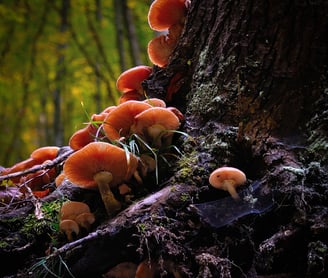Top 5 Edible Plants You Can Find in the Wild
FOODBUSHCRAFTEDUCATION


Nature has always provided us with a bounty of nutritious and delicious foods.
Beyond the supermarket shelves, the wilderness offers a plethora of edible plants that can satisfy our hunger and tickle our taste buds. Foraging for wild edibles is not only a fun and adventurous activity but also a way to reconnect with nature and learn more about the world around us. In this blog post, we will explore five delectable and nutritious edible plants you can find in the wild.
Wild Berries: Berries are one of nature's sweetest treats, and many of them grow abundantly in the wild. Blueberries, blackberries, raspberries, and strawberries are some of the most common wild berry varieties you may encounter while foraging. Rich in antioxidants, vitamins, and fiber, wild berries not only taste delightful but also offer numerous health benefits. Remember to ensure proper identification before consuming any wild berries, as some poisonous look-alikes may be lurking nearby.
Dandelion Greens: Often considered a pesky weed in our gardens, dandelions are a treasure trove of nutrition. The young leaves of the dandelion plant can be harvested and used in salads, soups, or sautéed as a delicious and nutritious green. Dandelion greens are rich in vitamins A, C, and K, as well as calcium, iron, and antioxidants. Their slightly bitter flavor adds a delightful tang to any dish.
Nettle: Though stinging nettle may be infamous for its painful prickles, it has been valued for centuries as a highly nutritious and versatile edible plant. Once properly cooked or dried, the stinging hairs lose their sting, leaving you with a powerhouse of vitamins, minerals, and protein. Nettle can be used to make tea, soups, and even pesto, providing a unique and earthy flavor that's sure to delight your taste buds.
Wild Garlic: Wild garlic, also known as ramps or wild leeks, is a pungent plant found in wooded areas across many regions. Both the leaves and bulbs of wild garlic are edible and offer a garlicky and onion-like flavor. You can add wild garlic to salads, stir-fries, or even use it as a substitute for traditional garlic in various recipes. Apart from its delightful taste, wild garlic also boasts anti-inflammatory properties and is rich in vitamins A and C.
Wild Asparagus: Foraging for wild asparagus can be a rewarding experience. This nutritious and delicious vegetable grows in various parts of the world, often in sandy or loamy soils near riverbanks or meadows. Wild asparagus has a more intense flavor than its cultivated counterpart, making it a delectable addition to soups, salads, or pasta dishes. It's also an excellent source of vitamins A, C, E, and K, as well as fiber and folate.
Conclusion: Exploring the wilderness and foraging for edible plants can be an enriching and rewarding experience. However, it's crucial to approach wild foraging with caution and proper knowledge. Before consuming any wild plants, make sure to research and learn about their identification, potential look-alikes, and potential hazards. By doing so, you can enjoy the delicious bounty that nature offers while staying safe and connected to the natural world. So, next time you venture into the wild, keep an eye out for these five edible plants, and embark on a culinary adventure that will awaken your taste buds and nourish your body. Happy foraging!
